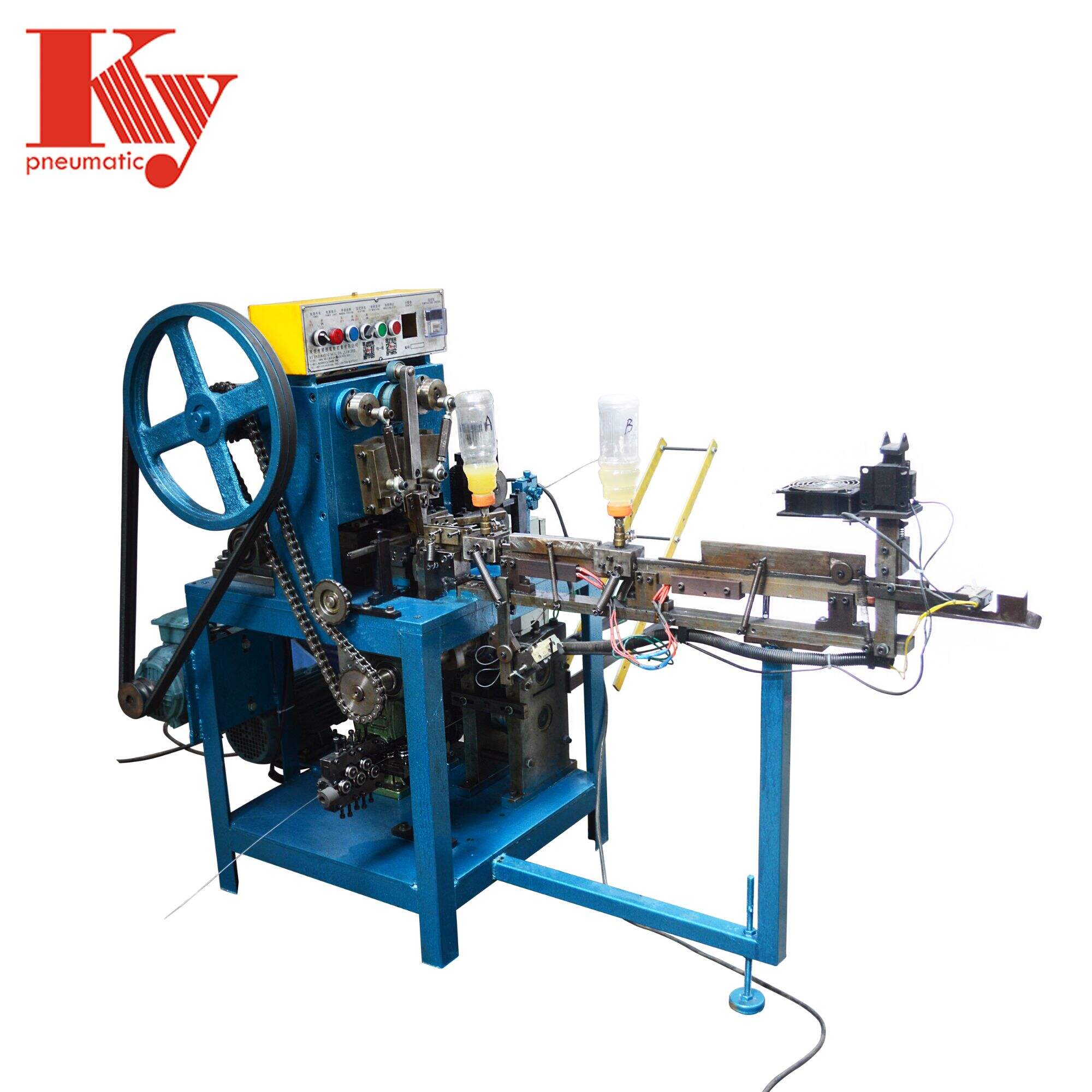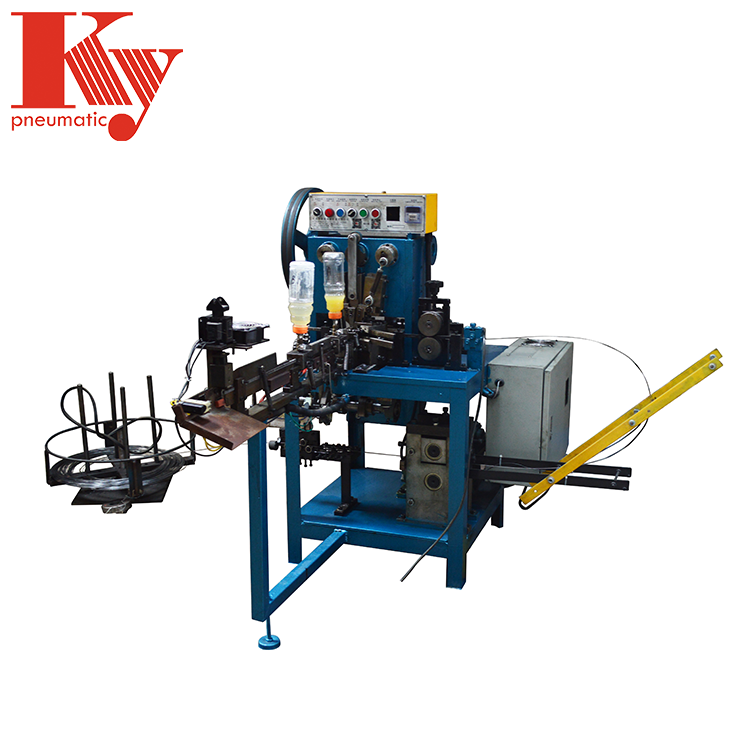ข้อดีของการใช้เหล็กคาร์บอนสูง 4K(90) ในการผลิตหมุด
ความแข็งแรงและทนทานยอดเยี่ยมในการผลิตตะปู
ความแข็งแรงดึงสูงสำหรับการยึดที่น่าเชื่อถือ
ในการผลิตลูกเรือ ผู้ผลิตต่างทราบดีว่าวัสดุที่ต้องการคุณสมบัติแรงดึงสูงมีความสำคัญต่อการยึดชิ้นส่วนต่างๆ เข้าด้วยกันอย่างมีประสิทธิภาพ การเปลี่ยนมาใช้เหล็กกล้าคาร์บอนสูงเกรด 4K ในการผลิตลูกเรือจึงสร้างความแตกต่างที่ชัดเจนในแง่ของความแข็งแรง โดยมักมีค่าแรงดึงอยู่ที่ระดับประมาณ XX MPa ลูกเรือที่แข็งแรงขึ้นนี้สามารถยึดติดได้ดีแม้ในสภาพแวดล้อมที่ยากลำบากตามหน้างาน ซึ่งหมายถึงการลดการแตกหัก และลดเวลาที่ต้องเสียไปกับการแก้ปัญหาภายหลัง ทีมงานก่อสร้างและอู่ซ่อมรถยนต์ให้ความชื่นชมคุณสมบัตินี้เป็นพิเศษ เนื่องจากงานของพวกเขาต้องพึ่งพาตัวยึดที่ไม่หลุดออกเมื่อเจอแรงดันหรือความเครียด สำหรับผู้ที่ต้องทำงานกับวัสดุหนักเป็นประจำทุกวัน การมีลูกเรือที่ยึดติดแน่นอนนำมาซึ่งผลลัพธ์ที่ดีกว่าในการทำงาน และประหยัดค่าใช้จ่ายในระยะยาว เพราะมีความจำเป็นในการเปลี่ยนทดแทนน้อยกว่าทางเลือกที่ถูกกว่า
ลวดเย็บเหล็กกล้าคาร์บอนสูงทำงานได้ดีมากเมื่อความแข็งแรงมีความสำคัญสูงสุด ในงานก่อสร้างที่สำคัญหรือสภาพแวดล้อมอุตสาหกรรม การมีตัวยึดที่เชื่อถือได้ช่วยสร้างความแตกต่างอย่างมากในการรักษาความปลอดภัยและยึดสิ่งต่าง ๆ เข้าด้วยกันอย่างเหมาะสม ลวดเย็บประเภทนี้ถูกใช้ในอาคาร สะพาน และเครื่องจักรทั่วไป เพราะไม่มีใครต้องการให้สลักเกลียวหลุดออกภายในไม่กี่เดือน ระดับเกรด 4K โดยเฉพาะโดดเด่นเรื่องความทนทาน ผู้รับเหมาก่อสร้างรายงานว่ามีปัญหาล้มเหลวเกิดขึ้นน้อยลงบนพื้นที่ก่อสร้างเมื่อเปลี่ยนมาใช้ลวดเย็บที่แข็งแรงขึ้นนี้ ซึ่งหมายความว่ามีเวลาหยุดทำงานเพื่อแก้ไขปัญหาในภายหลังลดลง สำหรับผู้ที่ทำงานติดตั้งระยะยาว ความน่าเชื่อถือในลักษณะนี้คุ้มค่ามากในระยะเวลายาว
ความต้านทานแรงกระแทกในแอปพลิเคชันที่มีความเครียดสูง
เมื่อพูดถึงลูกแม็กซ์ (staples) การมีความทนทานต่อแรงกระแทกถือเป็นสิ่งสำคัญอย่างมาก โดยเฉพาะในสถานที่ที่มักเกิดการชนหรือกระแทกโดยไม่คาดคิด หากไม่มีความต้านทานแรงกระแทกที่ดี โครงสร้างต่าง ๆ ก็จะไม่สามารถรับแรงกดดันในสถานการณ์ที่เครียดได้ ตัวอย่างเช่น ลูกแม็กซ์ทำจากเหล็กคาร์บอนสูงแบบ 4K ซึ่งมีสมรรถนะในการรับแรงกระแทกได้ดีกว่าลูกแม็กซ์ทั่วไปมาก นั่นหมายความว่ามีโอกาสที่จะหักหรือแตกสูงน้อยมาก ช่างก่อสร้างต่างรู้ดีเรื่องนี้ เนื่องจากงานของพวกเขาต้องเผชิญกับการจัดการวัสดุที่หยาบคายและแรงที่เกิดขึ้นโดยไม่คาดคิดตลอดโครงการ การมีลูกแม็กซ์ที่ยึดแน่นแม้จะถูกใช้งานหนักก็มีความแตกต่างอย่างมากในการทำงานจริง
ลวดเย็บเหล็กกล้าคาร์บอนสูงมีความทนทานแม้ต้องเผชิญกับสภาพแวดล้อมที่รุนแรง จึงเป็นเหตุผลว่าทำไมหลายอุตสาหกรรมจึงพึ่งพาลวดเย็บชนิดนี้สำหรับงานที่หนักหน่วง สิ่งใดที่ทำให้ลวดเย็บเหล่านี้แตกต่างจากลวดเย็บทั่วไป? ก็คือมีความแข็งแรงกว่าโดยรวม และใช้งานได้นานกว่ามากภายใต้แรงกดดันอย่างต่อเนื่อง ลองนึกถึงไซต์งานก่อสร้างหรือสถานที่ในอุตสาหกรรมที่ลวดเย็บต้องถูกตอกทุกวัน บริษัทที่เปลี่ยนมาใช้วัสดุประเภทนี้มักจะพบว่าอุปกรณ์ของตนมีอายุการใช้งานยาวนานขึ้นโดยไม่เกิดการเสียหายกะทันหัน ต้นทุนเริ่มต้นอาจสูงกว่า แต่ส่วนใหญ่พบว่าคุ้มค่าในระยะยาวเพราะไม่จำเป็นต้องเปลี่ยนลวดเย็บบ่อยครั้ง สำหรับผู้ที่ทำงานกับเครื่องจักรหรือโครงสร้างที่ต้องการทางเลือกการยึดติดที่มีประสิทธิภาพ การลงทุนในลวดเย็บเหล็กกล้าคาร์บอนสูงคุณภาพดีมักหมายถึงปัญหาที่ลดลงในอนาคต และคุ้มค่ากับเงินที่จ่ายไป
ความต้านทานการสึกหรอที่เพิ่มขึ้นสำหรับตะปูที่ใช้งานยาวนาน
ลดแรงเสียดทานในกระบวนการผลิตความเร็วสูง
เมื่อมีแรงเสียดทานระหว่างลิ่มลวดกับเครื่องจักรที่ลิ่มลวดเคลื่อนผ่านลดลง สายการผลิตที่มีความเร็วสูงจะทำงานได้ดีขึ้นมาก ผู้ผลิตพบว่าการใช้วัสดุเช่นเหล็กคาร์บอนสูงเกรด 4K นั้นสร้างความแตกต่างอย่างแท้จริง วัสดุนี้สามารถทนต่อการสึกหรอได้ดี ทำให้กระบวนการผลิตดำเนินไปอย่างราบรื่นโดยไม่ต้องชะลอความเร็ว การวิจัยบางส่วนแสดงให้เห็นว่า การเปลี่ยนมาใช้ลิ่มลวดที่มีแรงเสียดทานต่ำนี้ สามารถเพิ่มความเร็วในการผลิตได้ราว 20 เปอร์เซ็นต์ ซึ่งหมายถึงการประหยัดต้นทุนที่เป็นรูปธรรมสำหรับธุรกิจ แรงเสียดทานที่ลดลงยังส่งผลให้เครื่องจักรติดขัดน้อยลงด้วย ผู้จัดการโรงงานต่างตระหนักดีถึงความสำคัญในเรื่องนี้ เนื่องจากทุกนาทีที่สูญเสียไปจากปัญหาอุดตันนั้นมีค่าใช้จ่ายทั้งเวลาและเงินทอง ดังนั้นจึงไม่น่าแปลกใจที่โรงงานหลายแห่งกำลังเปลี่ยนมาใช้วัสดุพิเศษเหล่านี้
ยืดอายุเครื่องมือเพื่อลดต้นทุน
เมื่อผู้ผลิตเลือกใช้ลูกเรือที่มีความทนทานต่อการสึกหรอ พวกเขาจะพบว่าเครื่องมือสึกหรอน้อยลง ซึ่งหมายความว่าอุปกรณ์การผลิตสามารถใช้งานได้นานขึ้นก่อนที่จะต้องเปลี่ยนใหม่ การเลือกใช้ลูกเรือเหล็กคาร์บอนสูงเกรด 4K ถือเป็นกลยุทธ์การลงทุนในระยะยาวที่มีเหตุผล เนื่องจากช่วยลดค่าใช้จ่ายในการบำรุงรักษา และลดความถี่ในการเปลี่ยนเครื่องมือทั้งชุด ตามรายงานล่าสุดจากหลายภาคส่วนการผลิต บริษัทต่างๆ รายงานว่าสามารถประหยัดงบประมาณด้านเครื่องมือโดยรวมได้ประมาณ 30 เปอร์เซ็นต์ เพียงแค่เปลี่ยนมาใช้ลูกเรือที่มีคุณภาพดีขึ้น ประหยัดได้มากขนาดนี้เป็นเพราะไม่ต้องเปลี่ยนเครื่องมือที่สึกหรอบ่อยครั้ง และหลีกเลี่ยงปัญหาต่างๆ ที่เกิดจากการสึกกร่อนก่อนวัยอันควร สำหรับผู้จัดการโรงงานที่ต้องคำนึงถึงตัวเลขทางการเงินแล้ว สิ่งนี้สะท้อนออกมาเป็นเงินที่ประหยัดได้จริงทุกเดือน พร้อมทั้งรักษาการดำเนินงานให้ดำเนินไปอย่างราบรื่นโดยไม่มีการหยุดชะงักที่ไม่คาดคิด
วิศวกรรมที่แม่นยำด้วยเหล็กคาร์บอนสูง 4K
การควบคุมความอดทนอย่างเข้มงวด (ความแม่นยำ ±0.1mm)
การได้ขนาดที่ถูกต้องมีความสำคัญมากเมื่อผลิตแม่แรงที่ทำงานร่วมกับเครื่องจักร เนื่องจากผู้ผลิตส่วนใหญ่ควบคุมความแม่นยำไว้สูงมากที่ประมาณ ±0.1 มม. สำหรับแม่แรงเหล็กคาร์บอนสูงชนิดนี้ ระดับความแม่นยำนี้ช่วยลดปัญหาการติดขัด และเพิ่มประสิทธิภาพการทำงานโดยรวม โลหะเหล็กคาร์บอนสูงมีความแข็งและความแข็งแรงสูงกว่าวัสดุอื่นๆ จึงมีความทนทานตามธรรมชาติ พนักงานโรงงานต่างรู้เรื่องนี้ดีจากประสบการณ์ที่ผ่านมาจากการเห็นว่าเกิดอะไรขึ้นเมื่อค่าความคลาดเคลื่อนหลุดจากมาตรฐานแม้เพียงเล็กน้อย การทดสอบจริงแสดงให้เห็นว่าแม่แรงที่ผลิตตามแบบที่กำหนดไว้แน่นอน มักจะมีอายุการใช้งานยาวนานกว่า และสร้างปัญหาน้อยกว่าในสายการผลิต สำหรับบริษัทที่ใช้ระบบอัตโนมัติ การลงทุนเพิ่มเติมเพื่อให้ได้มาซึ่งความแม่นยำนั้นคุ้มค่าอย่างมากในระยะยาว เพราะอุปกรณ์ที่เสียหายจะก่อให้เกิดค่าใช้จ่ายและทำให้แผนการผลิตล่าช้า
สมรรถนะที่คงที่ในระบบอัตโนมัติ
ลวดเย็บทำจากเหล็กคาร์บอนสูง 4K มีความสม่ำเสมอที่แท้จริงในแง่ของประสิทธิภาพ ซึ่งเป็นสิ่งสำคัญมากในการทำให้สายการผลิตอัตโนมัติทำงานได้อย่างราบรื่น อะไรคือเหตุผลที่ทำให้ลวดเย็บเหล่านี้ทำงานได้ดีเยี่ยม? ด้วยคุณภาพของเหล็กชนิดนี้สามารถทนต่อแรงกดดันอย่างต่อเนื่องจากการทำงานอัตโนมัติโดยไม่เกิดการเสียหายบ่อยครั้งหรือไม่จำเป็นต้องมีคนเข้าไปแก้ไขระหว่างกระบวนการผลิต อะไรที่ทำให้ลวดเย็บเหล่านี้มีความทนทานเพียงพอสำหรับสภาพแวดล้อมที่ต้องการสูงเช่นนี้? คำตอบคือเนื้อเหล็กคาร์บอนสูงที่ให้ความต้านทานต่อการสึกหรอได้อย่างยอดเยี่ยม พร้อมทั้งรักษากำลังโครงสร้างที่แข็งแรงตลอดการใช้งานซ้ำๆ ข้อมูลจากพื้นที่การผลิตบางแห่งชี้ให้เห็นว่า ประสิทธิภาพของลวดเย็บที่เชื่อถือได้สามารถเพิ่มอัตราการผลิตได้ประมาณ XX เปอร์เซ็นต์ จึงไม่น่าแปลกใจที่ผู้ผลิตจำนวนมากยินดีจ่ายเพิ่มเพื่อแลกกับวัสดุคุณภาพสำหรับระบบอัตโนมัติของตน นอกเหนือจากการป้องกันการหยุดชะงักของการผลิตแล้ว ความสม่ำเสมอที่เชื่อถือได้เช่นนี้ยังช่วยให้ทุกอย่างดำเนินไปอย่างต่อเนื่องในสภาพแวดล้อมการผลิตที่มีความเร็วสูงและปริมาณงานมาก ซึ่งแต่ละวินาทีมีความสำคัญอย่างยิ่ง
เครื่องทำตะปูลำดับนำ 4K High Carbon Steel
เครื่องทำตะปูเหล็กคาร์บอนสูง 4K(90): โซลูชันการผลิตอัตโนมัติ
เครื่องทำลวดเย็บกระดาษแบบ High Carbon Steel รุ่น 4K(90) สามารถผลิตลวดเย็บกระดาษได้หลายพันตัวทุกชั่วโมง ทำให้เป็นเครื่องจักรที่ทรงพลังสำหรับความต้องการการผลิตที่รวดเร็ว ด้วยคุณสมบัติที่เป็นแบบอัตโนมัติครบวงจรที่ติดตั้งมาในตัวเครื่อง มันช่วยลดค่าใช้จ่ายด้านแรงงาน พร้อมทั้งลดข้อผิดพลาดที่เกิดจากการทำงานแบบ manual ร้านผลิตขนาดเล็กจำนวนมากต่างพบว่าสามารถประหยัดค่าใช้จ่ายรายเดือนได้อย่างต่อเนื่อง หลังจากเปลี่ยนมาใช้อุปกรณ์ในลักษณะนี้ ผู้ใช้งานจริงต่างรายงานว่า ประสิทธิภาพการผลิตเพิ่มขึ้นอย่างมากเมื่อเลิกใช้วิธีการเก่า ผู้ประกอบการเจ้าของโรงงานคนหนึ่งกล่าวว่า ทีมงานของเขาสามารถรับมือกับคำสั่งซื้อได้มากขึ้นถึงสองเท่า โดยไม่ต้องเพิ่มพนักงานหรือทำงานล่วงเวลา ซึ่งสะท้อนให้เห็นอย่างชัดเจนว่า เครื่องจักรเหล่านี้ช่วยปรับกระบวนการทำงานประจำวันให้มีประสิทธิภาพมากขึ้นอย่างไรในโลกแห่งความเป็นจริง
เพื่อดูข้อมูลเพิ่มเติมเกี่ยวกับเครื่องนี้ คุณสามารถเข้าชมได้ที่ [เครื่องทำหมุดเหล็กคาร์บอนสูง 4K(90)](https://www.staplemakingmachines.com/4k90high-carbon-steel-staple-making-machine)

เครื่อง Fully Automatic Black Sharp Foot 90(4K): การผลิตด้วยความชาญฉลาด
เครื่อง Black Sharp Foot 90(4K) แบบอัตโนมัติเต็มรูปแบบนั้นถือเป็นหนึ่งในนวัตกรรมล่าสุดในเทคโนโลยีโรงงานอัจฉริยะ ที่ช่วยปรับกระบวนการทำงานการผลิตให้มีประสิทธิภาพมากยิ่งขึ้นด้วยการอัพเกรดระบบต่าง ๆ ให้เป็นดิจิทัล จุดเด่นของเครื่องนี้คืออะไรหรือ? โดยพื้นฐานแล้ว เครื่องนี้ช่วยให้ผู้ควบคุมสามารถตรวจสอบสถานะการทำงานจากที่ใดก็ได้ และปรับตั้งค่าต่าง ๆ โดยไม่จำเป็นต้องหยุดสายการผลิตทั้งหมด โรงงานที่นำเครื่องจักรประเภทนี้มาใช้ในกระบวนการผลิตปกติ มักจะเห็นตัวเลขประสิทธิภาพการทำงานที่ดีขึ้น และการหยุดชะงักเมื่อเกิดปัญหาต่าง ๆ ลดน้อยลงไปได้ ถ้ามองในภาพรวม การนำอุปกรณ์การผลิตอัจฉริยะมาใช้นั้นไม่ได้ช่วยประหยัดแค่เวลาและต้นทุนเท่านั้น แต่ยังช่วยให้บริษัทต่าง ๆ สามารถผลิตสินค้าได้มากขึ้น ในขณะที่ใช้ทรัพยากรทางวัตถุดิบโดยรวมลดลง ซึ่งเป็นสิ่งสำคัญอย่างมากในการลดต้นทุนและรักษาความสามารถในการแข่งขันในตลาดปัจจุบัน
สำรวจรายละเอียดเพิ่มเติมเกี่ยวกับคุณสมบัติล้ำสมัยโดยเข้าชม [เครื่อง Fully Automatic Black Sharp Foot 90(4K)](https://www.staplemakingmachines.com/fully-automatic-black-sharp-foot-904k-high-carbon-steel-staple-machine).

ความคุ้มค่าทางต้นทุนในการผลิตตะปูอุตสาหกรรม
กระบวนการผลิตที่ประหยัดพลังงาน
การลดการใช้พลังงานในการผลิตช่วยลดต้นทุนค่าใช้จ่ายโดยรวม ขณะเดียวกันก็เป็นประโยชน์ต่อสิ่งแวดล้อมอีกด้วย โรงงานที่ลงทุนในอุปกรณ์และวัสดุที่ดีขึ้น เช่น เหล็กกล้าคาร์บอนสูงแบบ 4K มักจะพบว่าค่าไฟฟ้าลดลงอย่างมาก ตัวอย่างเช่น แบริ่งทำจากเหล็กคาร์บอนสูงที่กล่าวถึงนี้ ทำงานได้ดีขึ้นเพราะเกิดแรงเสียดทานน้อยลงในขณะใช้งาน ทำให้เครื่องจักรต้องการพลังงานน้อยลงในการทำงานให้ลื่นไหล ตามข้อมูลจากอุตสาหกรรม บริษัทที่นำวิธีการที่มีประสิทธิภาพเหล่านี้มาใช้บ่อยครั้งสามารถประหยัดค่าใช้จ่ายด้านพลังงานได้ประมาณ XX% ซึ่งหมายความว่ามีเงินเหลือหมุนเวียนในธุรกิจมากขึ้น นอกจากการประหยัดเงินแล้ว การมุ่งเน้นเรื่องประสิทธิภาพพลังงานยังแสดงให้ลูกค้าและนักลงทุนเห็นว่าบริษัทมีความรับผิดชอบในการดำเนินธุรกิจ ซึ่งเป็นสิ่งสำคัญมากขึ้นเรื่อย ๆ ในตลาดปัจจุบันที่ใบรับรองด้านสิ่งแวดล้อมสามารถสร้างความแตกต่างได้อย่างแท้จริง
ลดของเสียจากวัสดุด้วยการออกแบบที่แม่นยำ
การคำนวณทางวิศวกรรมอย่างแม่นยำมีความแตกต่างอย่างมากในการลดวัสดุส่วนเกินที่ใช้ในการผลิตลวดเย็บ โดยสามารถประหยัดต้นทุนและเป็นมิตรต่อสิ่งแวดล้อมพร้อมกัน เมื่อบริษัทต่างๆ เริ่มใช้เครื่องมือเหล็กกล้าคาร์บอนสูงแบบ 4K บนสายการผลิต จะช่วยให้ตัดได้เนี้ยบและลดจำนวนลวดเย็บที่ชำรุดเสียหายที่ออกจากไลน์การผลิต สิ่งหนึ่งที่โดดเด่นเกี่ยวกับชิ้นส่วนเหล็กกล้าคาร์บอนสูงเหล่านี้คือ มันมีอายุการใช้งานที่ยาวนานกว่าและเหมาะสำหรับงานที่ละเอียดอ่อน ซึ่งทำให้โรงงานสามารถผลิตลวดเย็บที่เข้ากันได้อย่างพอดีแม่นยำ งานวิจัยบางชิ้นแสดงให้เห็นว่า การเปลี่ยนมาใช้เทคโนโลยีความแม่นยำแบบนี้สามารถลดเศษวัสดุเหลือทิ้งได้ราว XX เปอร์เซ็นต์ หมายความว่าจะมีขยะที่ไปยังหลุมฝังกลบลดลง และกำไรที่เพิ่มขึ้นสำหรับธุรกิจ บริษัทที่ลงทุนในการปรับปรุงเช่นนี้ ไม่ได้ประหยัดทรัพยากรเพียงอย่างเดียว แต่ยังช่วยให้ดำเนินกิจการได้อย่างราบรื่นในทุกๆ วัน และกำหนดมาตรฐานคุณภาพที่สูงขึ้นสำหรับทั้งอุตสาหกรรม
 EN
EN
 AR
AR
 BG
BG
 CS
CS
 FI
FI
 FR
FR
 DE
DE
 EL
EL
 HI
HI
 IT
IT
 JA
JA
 KO
KO
 PL
PL
 PT
PT
 RU
RU
 ES
ES
 TL
TL
 ID
ID
 LT
LT
 SR
SR
 UK
UK
 VI
VI
 SQ
SQ
 GL
GL
 HU
HU
 MT
MT
 TH
TH
 TR
TR
 AF
AF
 MS
MS
 AZ
AZ
 KA
KA
 BN
BN
 LO
LO
 LA
LA
 MI
MI
 MN
MN
 NE
NE
 KK
KK
 UZ
UZ

